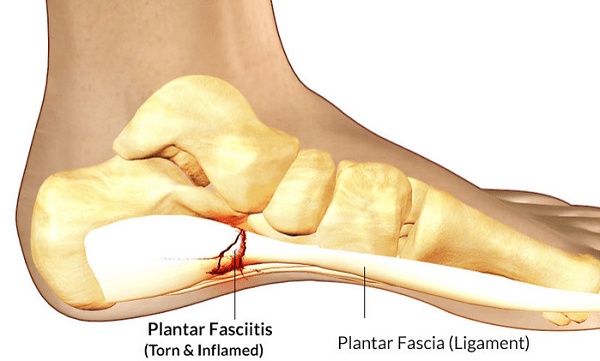Plantar Fasciitis: Sports Chiropractor Discusses Causes, Symptoms & Treatment Options. Speak To A Therapist Today. Call (24/7): 1300-003-777.
Plantar Fasciitis is a common condition that affects the foot and heel. Unsurprisingly the specific structure that is damaged or injured in Plantar Fasciitis is referred to as the Plantar Fascia. The plantar fascia is a thick, web-like ligament that extends from the heel to the toes. It’s major responsibility is to provide support to the arch of the foot as well as assist with walking. Plantar fasciitis is one of the most common orthopedic complaints seen in musculoskeletal therapy clinics. Normally, this broad ligament acts like a shock absorber however too much pressure on your feet can damage or tear the ligament. This process leads to the fascia becoming inflamed and subsequently being uncomfortable and painful during activity.
What Causes Plantar Fascia Pain?
Plantar fasciitis is usually the result of repetitive stress. It’s seen in athletes, runners, sports players or those with foot and arch disorders. The following factors which are listed below are a fantastic summary of the common causes of plantar fasciits:
- Foot and arch disorders such as high arch, flat feet, over pronation and supination.
- Excessive activities including running or plyometric type activities.
- Individuals who commence a brand new activity or are unaccustomed to particular exercise.
- Obesity may also be a risk factor as it places additional stress on the lower limb and kinetic chain.
- Weight and fluid gain associated with pregnancy.
- Poor or inappropriate footwear.
Symptoms Of Plantar Fascia Dysfunction
People suffering from plantar fasciitis usually present with symptoms including a throbbing or piercing pain that occurs when they’re walking or exercising. This pain usually diminishes when they’re resting. Other signs that you may be experiencing plantar fasciitis are that the sole of your foot is tender to touch and demonstrates signs of inflammation such as redness, heat and swelling.
How Is Foot Pain Diagnosed?
When consulting with a practitioner you’ll receive a lower limb, foot and ankle examination.
- Review your medical and health history. Typical questions that you may be asked include:
- How did the injury occur?
- How long have you been suffering from this pain?
- Have you experienced this previously? If so, what management (if any) did you seek?
- Can you describe the location and severity of the pain?
- Physical examination which includes palpation of the foot and ankle, muscle testing to assess symmetry and strength, range of motion assessment of the foot and ankle complex as well as orthopaedic and neurological testing.
- Referral for imaging may be clinically indicated to assist your practitioner in formulating an appropriate diagnosis. Such images may include X-ray (to rule out heel spur), Ultrasound, MRI or CT.
Plantar Fasciitis Treatment
Plantar fasciitis can be difficult to manage. Many clients see enormous benefit from conservative management such as Chiropractic and Physiotherapy treatment.
Chiropractic & Physiotherapy
- Mobilization of the foot and ankle bones to improve lower limb biomechanics
- Soft tissue massage to the plantar fascia to reduce spasm, tightness and pain
- Physiological therapeutics such as Ultrasound, Shockwave therapy and low level laser treatment to assist with reducing inflammation
- Devices such as orthotics, taping and braces may be recommended to assist your recovery
Corticosteroid Injections
Chiropractor Plantar Fasciitis Research
- There are a variety of treatment options which exist for managing Plantar Fasciitis including rest, stretching, strengthening, change of shoes, arch supports, orthotics, night splints, anti-inflammatory agents and surgery. Usually, plantar fasciitis can be treated successfully by tailoring treatment to an individual’s risk factors and preferences. Young, C. (2001). Treatment of plantar fasciitis. American Family Physician, 63(3); 477 – 478
- Foot orthoses produce small short-term benefits in function and may also produce small reductions in pain for people with plantar fasciitis. Long term benefit was not demonstrated. Landorf, K. (2006). Effectiveness of foot orthoses to treat plantar fasciitis: A randomized trial. JAMA, 166(12); 1305 – 1310

Additional Information
If you wish to continue your reading about Plantar Fasciitis and general heel pain please click here.
